Global Business: Analyzing Country Data for Business Decisions Report
VerifiedAdded on 2023/04/17
|5
|973
|394
Report
AI Summary
This report presents an analysis of socio-economic data for two fictitious countries to inform global business decisions. Part A provides three conclusions, each comparing the countries using variables like GDP, GDP per capita, population below the poverty line, and key exports, to assess market potential for different business scenarios such as automobile exports, agri-commodity exports, and manufacturing outsourcing. Part B includes a line graph comparing the GDP growth rates of Hong Kong and Indonesia from 2014 to 2024. Part C discusses licensing as a key entry mode into foreign markets, emphasizing its advantages in protecting intellectual property and ensuring quick product rollout, especially when compared to direct exports, and how it can be applied to a scenario involving a company with innovative products. The report utilizes economic indicators and relevant literature to support its conclusions and recommendations.
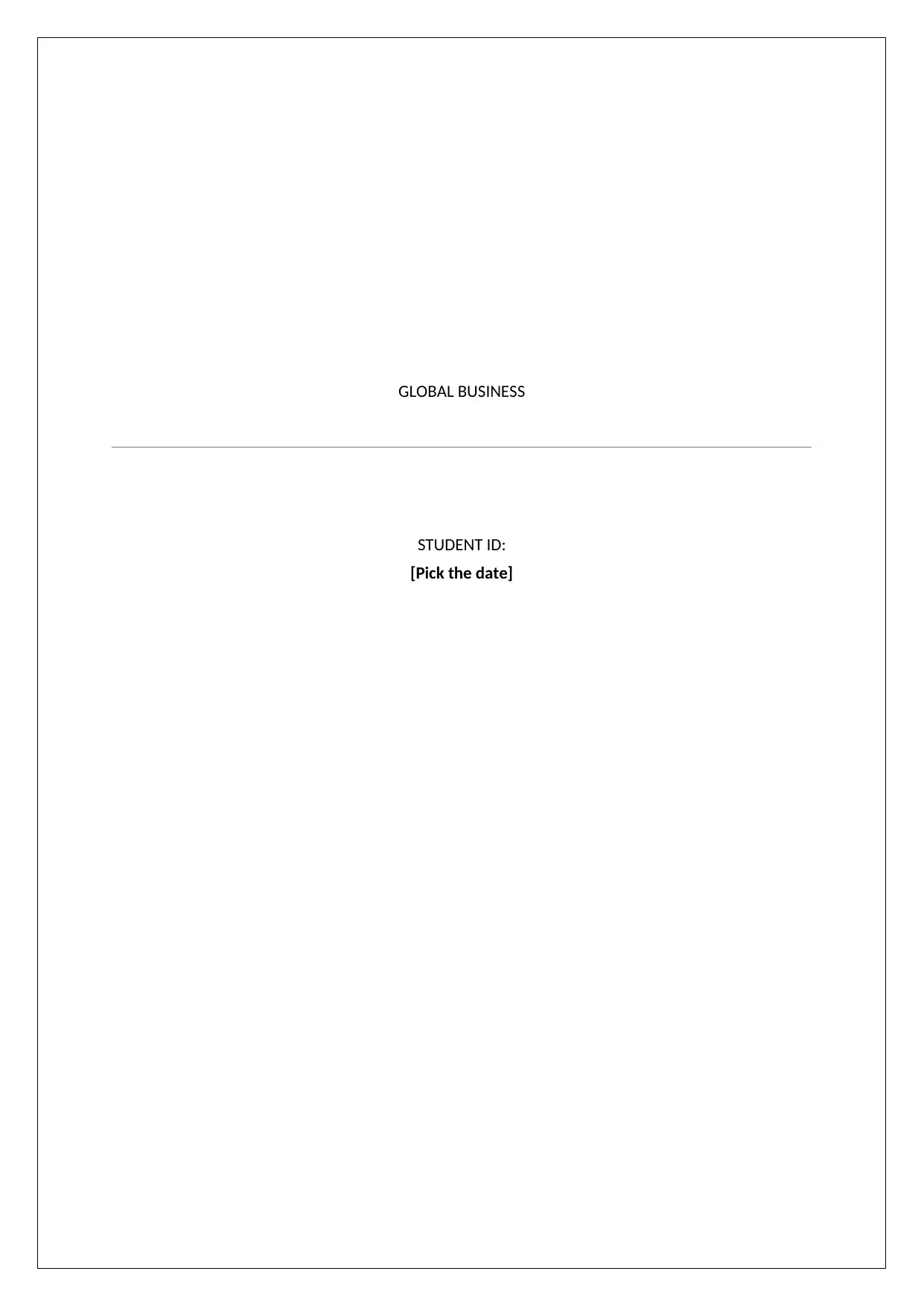
GLOBAL BUSINESS
STUDENT ID:
[Pick the date]
STUDENT ID:
[Pick the date]
Paraphrase This Document
Need a fresh take? Get an instant paraphrase of this document with our AI Paraphraser
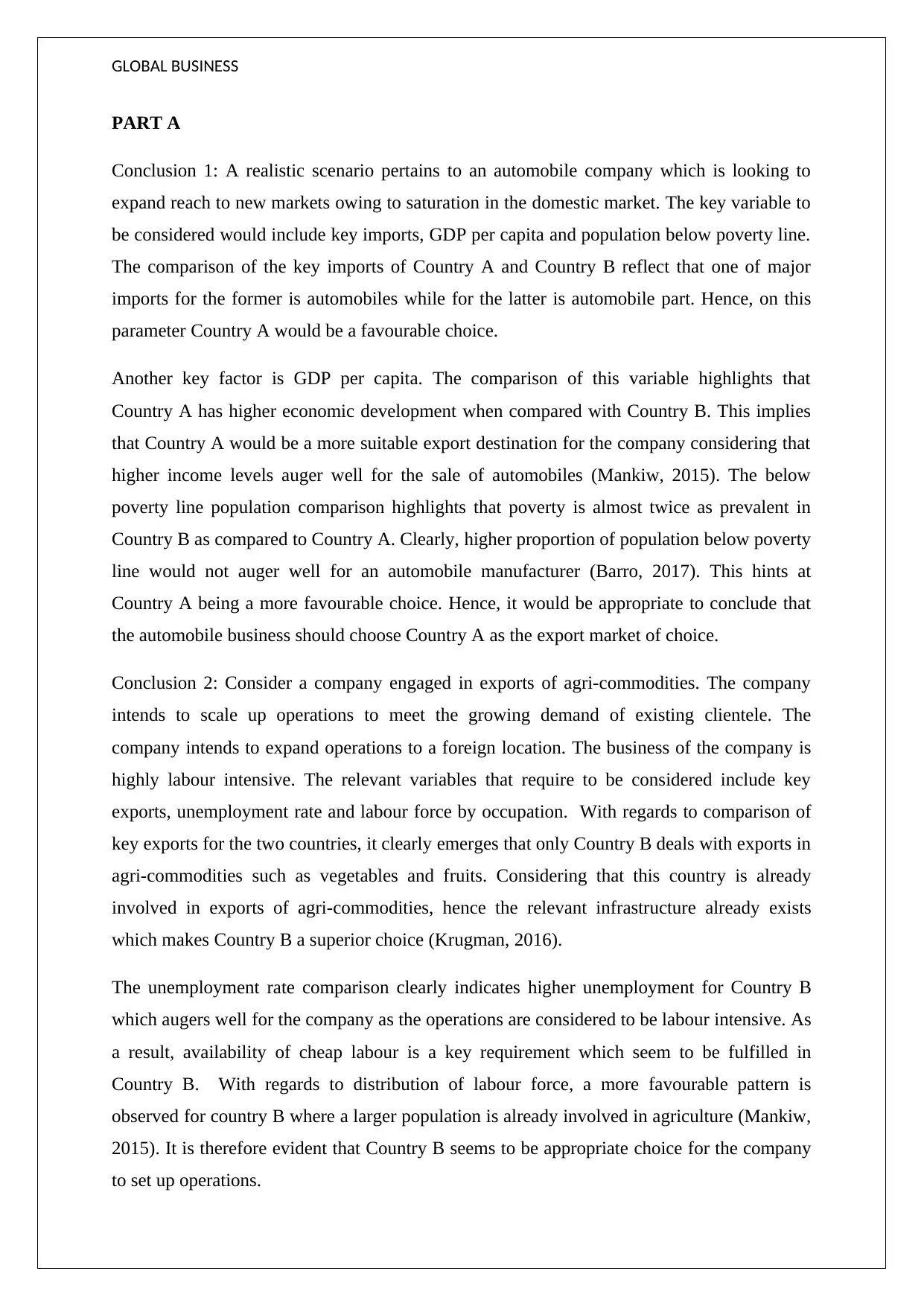
GLOBAL BUSINESS
PART A
Conclusion 1: A realistic scenario pertains to an automobile company which is looking to
expand reach to new markets owing to saturation in the domestic market. The key variable to
be considered would include key imports, GDP per capita and population below poverty line.
The comparison of the key imports of Country A and Country B reflect that one of major
imports for the former is automobiles while for the latter is automobile part. Hence, on this
parameter Country A would be a favourable choice.
Another key factor is GDP per capita. The comparison of this variable highlights that
Country A has higher economic development when compared with Country B. This implies
that Country A would be a more suitable export destination for the company considering that
higher income levels auger well for the sale of automobiles (Mankiw, 2015). The below
poverty line population comparison highlights that poverty is almost twice as prevalent in
Country B as compared to Country A. Clearly, higher proportion of population below poverty
line would not auger well for an automobile manufacturer (Barro, 2017). This hints at
Country A being a more favourable choice. Hence, it would be appropriate to conclude that
the automobile business should choose Country A as the export market of choice.
Conclusion 2: Consider a company engaged in exports of agri-commodities. The company
intends to scale up operations to meet the growing demand of existing clientele. The
company intends to expand operations to a foreign location. The business of the company is
highly labour intensive. The relevant variables that require to be considered include key
exports, unemployment rate and labour force by occupation. With regards to comparison of
key exports for the two countries, it clearly emerges that only Country B deals with exports in
agri-commodities such as vegetables and fruits. Considering that this country is already
involved in exports of agri-commodities, hence the relevant infrastructure already exists
which makes Country B a superior choice (Krugman, 2016).
The unemployment rate comparison clearly indicates higher unemployment for Country B
which augers well for the company as the operations are considered to be labour intensive. As
a result, availability of cheap labour is a key requirement which seem to be fulfilled in
Country B. With regards to distribution of labour force, a more favourable pattern is
observed for country B where a larger population is already involved in agriculture (Mankiw,
2015). It is therefore evident that Country B seems to be appropriate choice for the company
to set up operations.
PART A
Conclusion 1: A realistic scenario pertains to an automobile company which is looking to
expand reach to new markets owing to saturation in the domestic market. The key variable to
be considered would include key imports, GDP per capita and population below poverty line.
The comparison of the key imports of Country A and Country B reflect that one of major
imports for the former is automobiles while for the latter is automobile part. Hence, on this
parameter Country A would be a favourable choice.
Another key factor is GDP per capita. The comparison of this variable highlights that
Country A has higher economic development when compared with Country B. This implies
that Country A would be a more suitable export destination for the company considering that
higher income levels auger well for the sale of automobiles (Mankiw, 2015). The below
poverty line population comparison highlights that poverty is almost twice as prevalent in
Country B as compared to Country A. Clearly, higher proportion of population below poverty
line would not auger well for an automobile manufacturer (Barro, 2017). This hints at
Country A being a more favourable choice. Hence, it would be appropriate to conclude that
the automobile business should choose Country A as the export market of choice.
Conclusion 2: Consider a company engaged in exports of agri-commodities. The company
intends to scale up operations to meet the growing demand of existing clientele. The
company intends to expand operations to a foreign location. The business of the company is
highly labour intensive. The relevant variables that require to be considered include key
exports, unemployment rate and labour force by occupation. With regards to comparison of
key exports for the two countries, it clearly emerges that only Country B deals with exports in
agri-commodities such as vegetables and fruits. Considering that this country is already
involved in exports of agri-commodities, hence the relevant infrastructure already exists
which makes Country B a superior choice (Krugman, 2016).
The unemployment rate comparison clearly indicates higher unemployment for Country B
which augers well for the company as the operations are considered to be labour intensive. As
a result, availability of cheap labour is a key requirement which seem to be fulfilled in
Country B. With regards to distribution of labour force, a more favourable pattern is
observed for country B where a larger population is already involved in agriculture (Mankiw,
2015). It is therefore evident that Country B seems to be appropriate choice for the company
to set up operations.
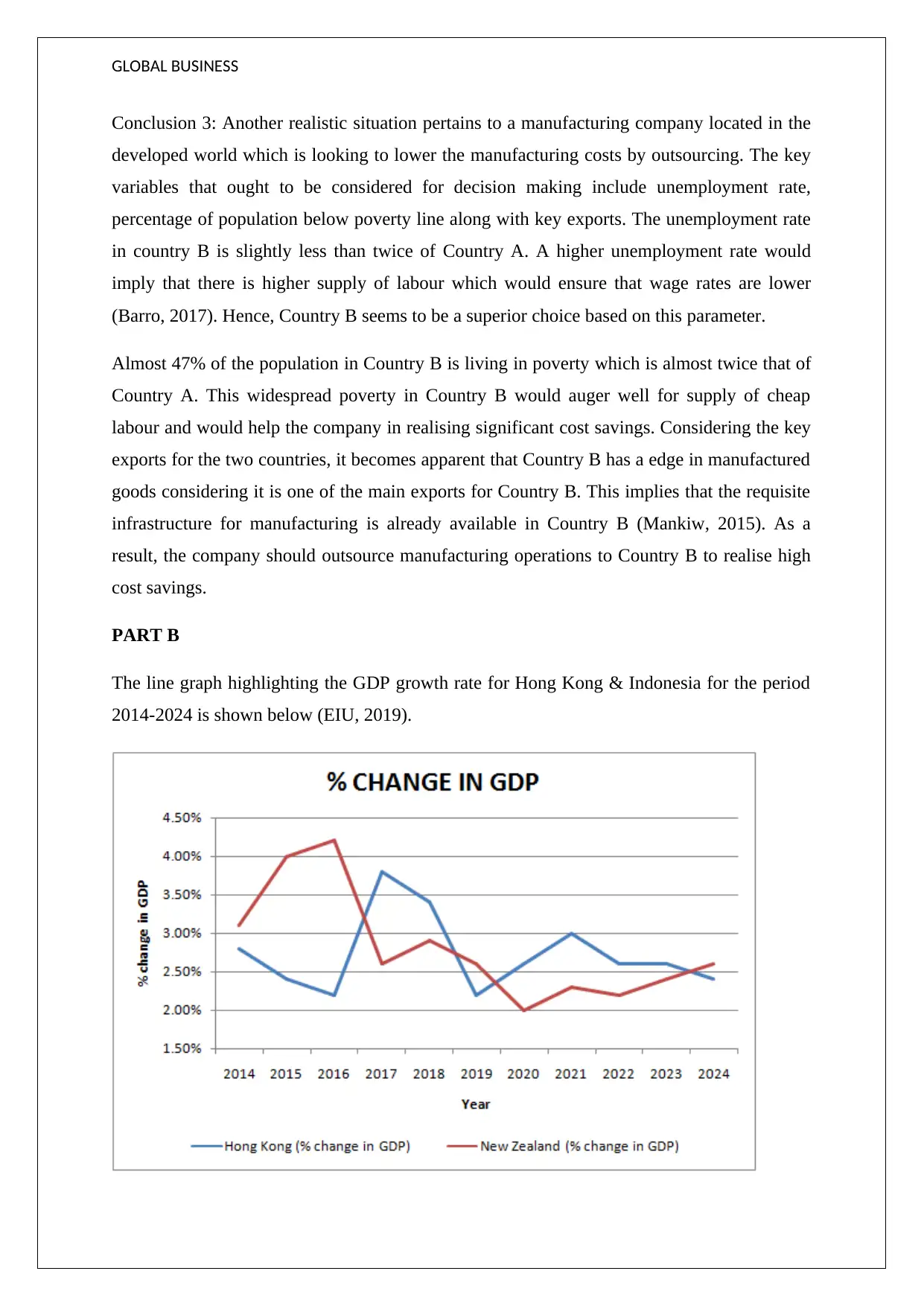
GLOBAL BUSINESS
Conclusion 3: Another realistic situation pertains to a manufacturing company located in the
developed world which is looking to lower the manufacturing costs by outsourcing. The key
variables that ought to be considered for decision making include unemployment rate,
percentage of population below poverty line along with key exports. The unemployment rate
in country B is slightly less than twice of Country A. A higher unemployment rate would
imply that there is higher supply of labour which would ensure that wage rates are lower
(Barro, 2017). Hence, Country B seems to be a superior choice based on this parameter.
Almost 47% of the population in Country B is living in poverty which is almost twice that of
Country A. This widespread poverty in Country B would auger well for supply of cheap
labour and would help the company in realising significant cost savings. Considering the key
exports for the two countries, it becomes apparent that Country B has a edge in manufactured
goods considering it is one of the main exports for Country B. This implies that the requisite
infrastructure for manufacturing is already available in Country B (Mankiw, 2015). As a
result, the company should outsource manufacturing operations to Country B to realise high
cost savings.
PART B
The line graph highlighting the GDP growth rate for Hong Kong & Indonesia for the period
2014-2024 is shown below (EIU, 2019).
Conclusion 3: Another realistic situation pertains to a manufacturing company located in the
developed world which is looking to lower the manufacturing costs by outsourcing. The key
variables that ought to be considered for decision making include unemployment rate,
percentage of population below poverty line along with key exports. The unemployment rate
in country B is slightly less than twice of Country A. A higher unemployment rate would
imply that there is higher supply of labour which would ensure that wage rates are lower
(Barro, 2017). Hence, Country B seems to be a superior choice based on this parameter.
Almost 47% of the population in Country B is living in poverty which is almost twice that of
Country A. This widespread poverty in Country B would auger well for supply of cheap
labour and would help the company in realising significant cost savings. Considering the key
exports for the two countries, it becomes apparent that Country B has a edge in manufactured
goods considering it is one of the main exports for Country B. This implies that the requisite
infrastructure for manufacturing is already available in Country B (Mankiw, 2015). As a
result, the company should outsource manufacturing operations to Country B to realise high
cost savings.
PART B
The line graph highlighting the GDP growth rate for Hong Kong & Indonesia for the period
2014-2024 is shown below (EIU, 2019).
⊘ This is a preview!⊘
Do you want full access?
Subscribe today to unlock all pages.

Trusted by 1+ million students worldwide
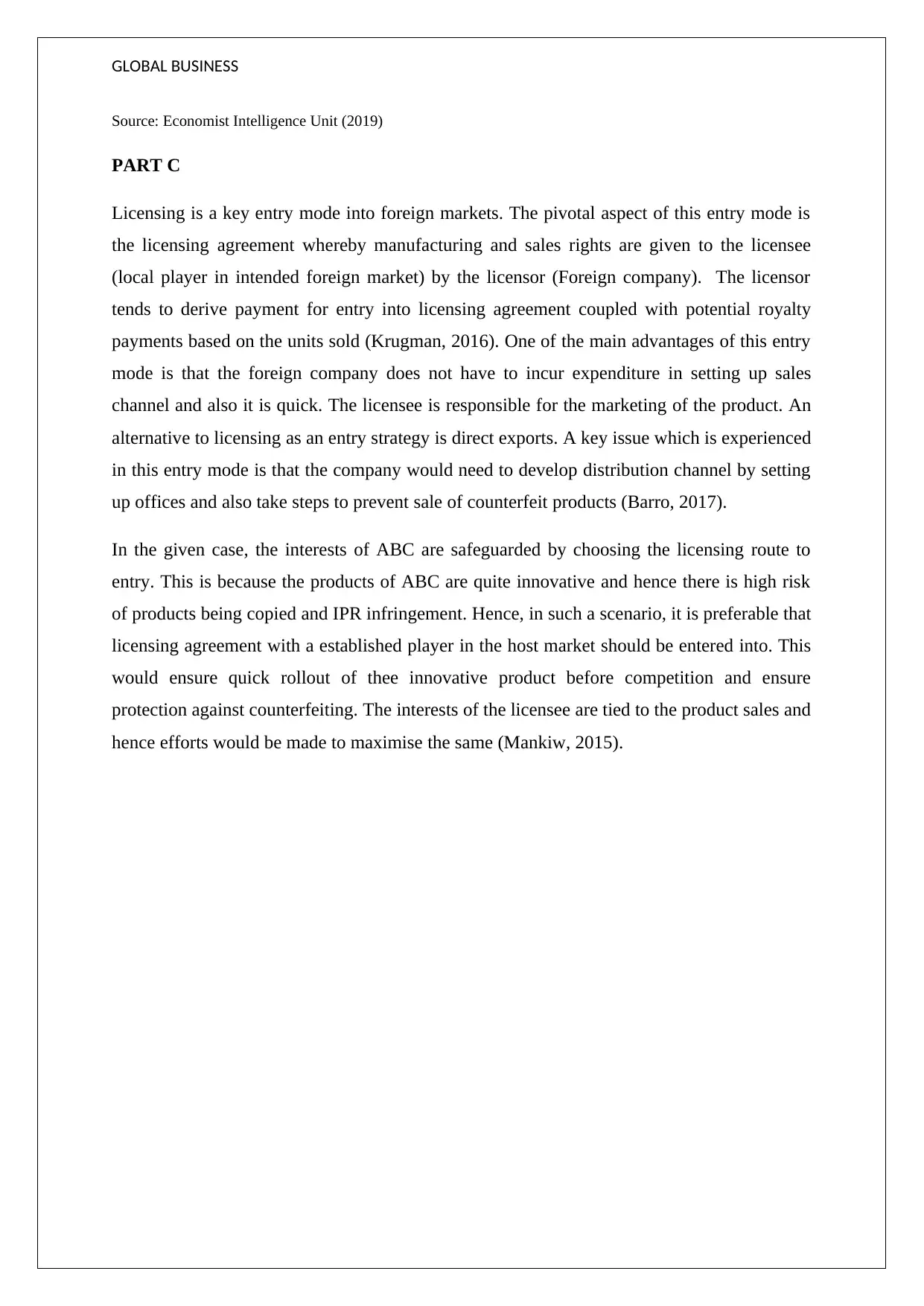
GLOBAL BUSINESS
Source: Economist Intelligence Unit (2019)
PART C
Licensing is a key entry mode into foreign markets. The pivotal aspect of this entry mode is
the licensing agreement whereby manufacturing and sales rights are given to the licensee
(local player in intended foreign market) by the licensor (Foreign company). The licensor
tends to derive payment for entry into licensing agreement coupled with potential royalty
payments based on the units sold (Krugman, 2016). One of the main advantages of this entry
mode is that the foreign company does not have to incur expenditure in setting up sales
channel and also it is quick. The licensee is responsible for the marketing of the product. An
alternative to licensing as an entry strategy is direct exports. A key issue which is experienced
in this entry mode is that the company would need to develop distribution channel by setting
up offices and also take steps to prevent sale of counterfeit products (Barro, 2017).
In the given case, the interests of ABC are safeguarded by choosing the licensing route to
entry. This is because the products of ABC are quite innovative and hence there is high risk
of products being copied and IPR infringement. Hence, in such a scenario, it is preferable that
licensing agreement with a established player in the host market should be entered into. This
would ensure quick rollout of thee innovative product before competition and ensure
protection against counterfeiting. The interests of the licensee are tied to the product sales and
hence efforts would be made to maximise the same (Mankiw, 2015).
Source: Economist Intelligence Unit (2019)
PART C
Licensing is a key entry mode into foreign markets. The pivotal aspect of this entry mode is
the licensing agreement whereby manufacturing and sales rights are given to the licensee
(local player in intended foreign market) by the licensor (Foreign company). The licensor
tends to derive payment for entry into licensing agreement coupled with potential royalty
payments based on the units sold (Krugman, 2016). One of the main advantages of this entry
mode is that the foreign company does not have to incur expenditure in setting up sales
channel and also it is quick. The licensee is responsible for the marketing of the product. An
alternative to licensing as an entry strategy is direct exports. A key issue which is experienced
in this entry mode is that the company would need to develop distribution channel by setting
up offices and also take steps to prevent sale of counterfeit products (Barro, 2017).
In the given case, the interests of ABC are safeguarded by choosing the licensing route to
entry. This is because the products of ABC are quite innovative and hence there is high risk
of products being copied and IPR infringement. Hence, in such a scenario, it is preferable that
licensing agreement with a established player in the host market should be entered into. This
would ensure quick rollout of thee innovative product before competition and ensure
protection against counterfeiting. The interests of the licensee are tied to the product sales and
hence efforts would be made to maximise the same (Mankiw, 2015).
Paraphrase This Document
Need a fresh take? Get an instant paraphrase of this document with our AI Paraphraser
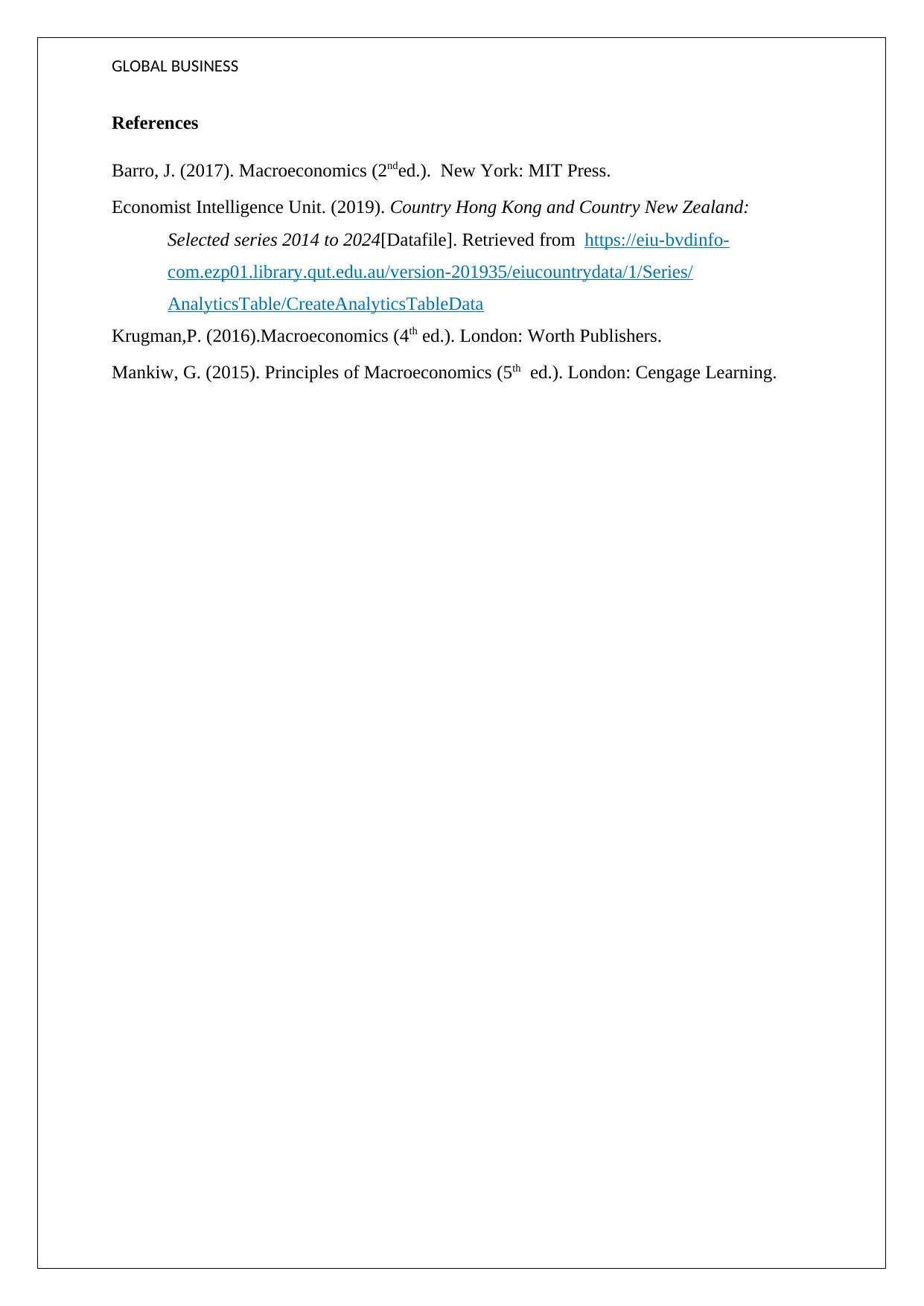
GLOBAL BUSINESS
References
Barro, J. (2017). Macroeconomics (2nded.). New York: MIT Press.
Economist Intelligence Unit. (2019). Country Hong Kong and Country New Zealand:
Selected series 2014 to 2024[Datafile]. Retrieved from https://eiu-bvdinfo-
com.ezp01.library.qut.edu.au/version-201935/eiucountrydata/1/Series/
AnalyticsTable/CreateAnalyticsTableData
Krugman,P. (2016).Macroeconomics (4th ed.). London: Worth Publishers.
Mankiw, G. (2015). Principles of Macroeconomics (5th ed.). London: Cengage Learning.
References
Barro, J. (2017). Macroeconomics (2nded.). New York: MIT Press.
Economist Intelligence Unit. (2019). Country Hong Kong and Country New Zealand:
Selected series 2014 to 2024[Datafile]. Retrieved from https://eiu-bvdinfo-
com.ezp01.library.qut.edu.au/version-201935/eiucountrydata/1/Series/
AnalyticsTable/CreateAnalyticsTableData
Krugman,P. (2016).Macroeconomics (4th ed.). London: Worth Publishers.
Mankiw, G. (2015). Principles of Macroeconomics (5th ed.). London: Cengage Learning.
1 out of 5
Your All-in-One AI-Powered Toolkit for Academic Success.
+13062052269
info@desklib.com
Available 24*7 on WhatsApp / Email
![[object Object]](/_next/static/media/star-bottom.7253800d.svg)
Unlock your academic potential
Copyright © 2020–2025 A2Z Services. All Rights Reserved. Developed and managed by ZUCOL.

